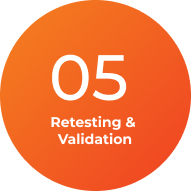BENCHMARK YOUR INTERNAL INFRASTRUCTURE
INTERNAL PENETRATION TESTING
Internal Penetration Testing involves simulating cyber-attacks from an insider’s perspective to target an organization’s internal networks and mission critical systems. The primary objective is to identify and exploit vulnerabilities, thereby helping organizations to gain a more comprehensive understanding of the threats, risks, and impacts they face, and to proactively improve their cybersecurity defenses. Because internal assets are meant to stay internal!
Tell us
about your scope
What You'll Get

Key findings, risks, impacts, and critical recommendations.

Overview of methodologies, standards, tactics, and techniques used.

Detailed vulnerability analysis, reproduction steps, PoC, evidence.

Strategic and tactical walkthrough on how to fix vulnerabilities.

Comprehensive advice on cybersecurity enhancement strategies.

Offered once vulnerabilities are fixed.
What is Internal Penetration Testing?
The perimeter cannot be relied upon exclusively to protect internal systems. An attacker only needs one path to gain access. Once inside, an insecure internal network can be exploited to rapidly escalate privileges. Internal attacks have severe results and often go undetected for longer periods.
Performing an internal pen test identifies vulnerabilities in critical internal assets, demonstrates the impact if exploited, and provides clear direction on improvements that can be implemented to mitigate that risk. At Secragon, we specialize in penetration tests that are 95% manual, designed to replicate real-world hacking, and conducted by experienced ethical hackers. Along with leveraging industry standard methodologies to ensure a thorough security assessment is conducted under safe and controlled conditions, our expert team utilizes an advanced mix of public and in-house developed exploits and in-depth analysis to discover vulnerabilities not yet published and often not yet discovered. The objective is to penetrate target systems, assess the robustness of the internal network’s security, and enable the organization to implement protective measures to mitigate risk. Our service not only identifies security gaps but also provides a prioritized action plan with remediation guidance to help you address any risks found.
We don’t just point out security holes; we help you solve them.

Lower the chances of data breaches and unauthorized insider access by identifying and patching weaknesses.
Gain in-depth awareness of your internal risk profile, providing crucial intelligence for managerial decision-making in cybersecurity.
Test the investments you have made in your cybersecurity, and implement controls to protect crucial internal assets like data centers and proprietary software.
Many industries require regular internal penetration testing for compliance with sector-specific regulations or standards. By conducting these tests, you can demonstrate your commitment to cybersecurity, avoid potential penalties, and maintain the trust of clients and stakeholders.
Use insights from the pentest to allocate resources strategically, focusing on your network’s vulnerable areas.
Internal systems are prime hunting grounds for ransomware attacks, which can paralyze business operations and compromise critical data.
Why Conduct an Internal Penetration Test?
Holes in your system could lead to data breaches, service outages, reputational damage, and regulatory penalties. Conducting an internal penetration test provides invaluable insights into the potential security risks your organization may face from insider threats. Here are the benefits your organization will gain by partnering with our team for a project.
PROTECT AGAINST THE LATEST THREATS
When Should You Perform an Internal Penetration Test?
Industry best practices recommend conducting internal pen tests at least annually to stay ahead of emerging cybersecurity threats. Performing an internal penetration test is crucial for assessing the security of an organization’s internal network. You should consider conducting an internal penetration test in the following situations:
After Significant Changes
Following substantial updates to network infrastructure or the deployment of new systems.
After Third-Party Services Changes
When changes are made involving third-party services or when integrating new vendor products into your network.
Before Launch of New Services
Following substantial updates to network infrastructure or the deployment of new systems.
Regularly Scheduled Intervals
As part of a proactive cybersecurity strategy, periodic tests can uncover vulnerabilities that may develop over time.
Annually
As part of a proactive security strategy and to comply with industry best practices and regulatory requirements.
Post-Breach or Security Incident
To ensure all vulnerabilities have been addressed and the system is secure.
We Provide Expert Solutions And Definite Results

Transparent
Pricing
Clear, upfront, with no
hidden costs.

Dedicated Project
Manager
Your security is our
commitment.

Retesting After
Fixes
Ensuring threats are
truly eliminated.

Affordable
Expertise
Premium protection,
reasonable rates.

Customized
Approach
Solutions fitted to your
specific needs.

Proactive
Protection
Effectively securing your
digital assets.
What Will be Assessed During an Internal Penetration Test?
Our assessment encompasses various components of your
organization’s internal IT systems:
Active Directory
Analysis of user management, password
policies, and more.
Authentication
Testing across both legacy and
contemporary authentication protocols.
File Servers & Domain Controllers
Evaluating access controls, permissions,
and configurations.
Data Security
Analyzing permissions, access controls, and encryption standards.
Network Devices
Evaluating router, switch, and other device configurations.
And More
Network segmentation, legacy systems,
patch management strategies, endpoints,
etc.
Our Penetration Testing Process
If your organization has not gone through a penetration test before, you may not know what to expect. Even if you have, maybe you are wondering what Secragon’s stages of penetration testing are. Here is a high-level break down of each step of our proven process:

Activities: Engage stakeholders, define targets, plan logistics for efficient, transparent execution.
Outcomes: Scope Validation, Proposal, Contract.

Activities: Environment preparation, OSINT collection, attack scenario planning.
Outcomes: Strategy Development, Threat Insight.

Activities: Vulnerability identification, active exploitation, privilege escalation, execution of realistic attack scenarios, data and information collection, persistence maintenance, and documentation of steps.
Outcomes: Comprehensive Report, including Executive Summary, Technical Details, Impact Analysis, Recommendations.

Activities: Supporting vulnerability remediation with actionable steps and advice, answering follow-up queries.
Outcomes: Remediation Plan, Security Enhancement.

Activities: Validate the effectiveness of remediation efforts through complementary retesting.
Outcomes: Re-test Results, Attestation.
Frequently Asked Questions
Couldn’t find the information you were looking for?
Download The
Secragon Internal Penetration Testing Sample Report!

SECRAGON, YOUR CYBERSECURITY PROVIDER
We, at Secragon, are a team of certified ethical hackers, visionary security engineers, seasoned penetration testers, and committed project managers… but first of all – professionals, who LIVE and BREATHE Offensive Security. Along the list of qualifications, titles, and credentials, we bring a real “think outside of the box” mindset to every project and we constantly strive to learn, explore, and push forward to master complex concepts and deliver top-notch services and results.


